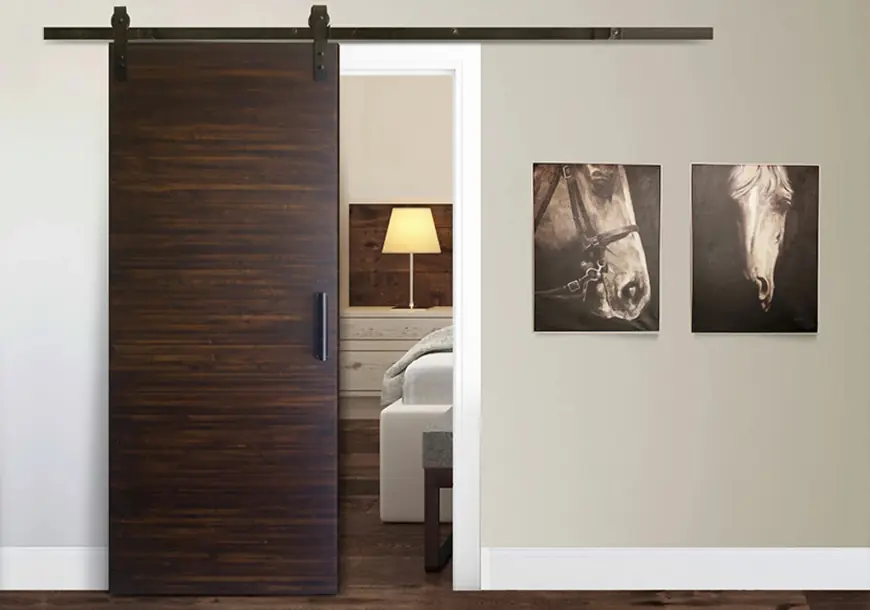Modern Barn Doors vs. Traditional Sliding Doors: What’s the Difference?
Confused between modern barn doors and sliding doors? Learn how each option compares in design, privacy, installation, and space-saving features.
When it comes to interior design and functional door solutions, both modern barn doors and traditional sliding doors have become popular choices. These two types of doors serve similar purposes—saving space and adding visual interest—but they differ significantly in aesthetics, construction, and functionality.
Whether you’re remodeling your home or looking for a stylish update, understanding the key differences between these options will help you make the best choice for your space.
1. Design Aesthetics
One of the most noticeable differences between modern barn doors and traditional sliding doors is their appearance.
Modern Barn Doors
Modern barn doors are known for their bold presence and statement-making design. While inspired by classic farmhouse elements, the modern version has evolved to suit contemporary interiors. You’ll often find sleek finishes, minimalist hardware, and cleaner lines. These doors add texture and warmth to modern spaces, making them ideal for homes that balance comfort with a polished look.
Popular styles include:
-
Flat-panel wood with metal tracks
-
Frosted or tinted glass inserts
-
Matte black or brushed nickel hardware
Traditional Sliding Doors
Traditional sliding doors, on the other hand, are typically more subtle and functional in design. Think of sliding patio doors or closet doors that glide along a track and blend into the background. These doors are often made of glass, composite, or laminate, and they usually serve a more utilitarian purpose.
They’re great for spaces where the door needs to disappear visually or allow for maximum natural light.
2. Functionality and Use
Both modern barn doors and traditional sliding doors slide open to save space, but how they operate and where they are used differ.
Modern Barn Doors
However, modern barn doors attach themselves to the exposed hardware outside the wall. There is a more simple installation because no hollow wall cavities are required for the door to slide into. At the same time, a level stretch of wall equal to one door's width is required.

Common uses include:
-
Bedroom entrances
-
Office dividers
-
Bathroom doors (with privacy locks)
-
Pantry or laundry room covers
They add drama and act as a design focal point.
Traditional Sliding Doors
Traditional sliding doors typically slide within a track, either along the same plane (like bypass closet doors) or into the wall (as with pocket doors). They’re often used in tighter spaces or where a flush finish is desired.
Typical uses:
-
Closets and wardrobes
-
Patio or balcony access
-
Areas with limited swing space
They’re functional, discreet, and effective for separating spaces without visual weight.
3. Installation Requirements
Modern Barn Doors
Installing a modern barn door is relatively straightforward. Since the track system is mounted on the wall, there’s no need for structural changes like removing drywall or modifying the framing.
However, it’s important to:
-
Ensure you have enough wall space beside the opening
-
Mount the track into wall studs for safety
-
Consider soundproofing or privacy needs, since barn doors don’t seal like traditional doors
Traditional Sliding Doors
Historically, sliding doors required somewhat more involved installation processes, and the pocket door ranked among these. With a pocket door, part of the wall must be opened up to create a cavity, which could require rerouting of electrical or plumbing lines.
Closet sliders and patio doors are easier to install but may need floor guides or recessed tracks.
4. Privacy and Sound Control
Modern Barn Doors
Generally, modern barn doors cannot be sealed tightly against the wall, which limits privacy and sound isolation. This might be problematic for bedrooms or bathrooms unless additional weather stripping or seals are used.
Traditional Sliding Doors
Traditional sliding doors can gain a slight edge in soundproofing and privacy, because they are often seated within the frame. Specifically, if properly installed, they may close more tightly than barn doors.
5. Space Considerations
Both door types are excellent space-savers, but they offer different types of space optimization.
-
Modern barn doors require wall clearance next to the opening.
-
Traditional sliding doors (especially pocket doors) require wall cavity space but no exterior clearance.
If you're working with tight interiors or limited wall area, a traditional sliding door might make more sense.
6. Cost Comparison
Cost can vary depending on materials, customization, and installation.
-
Modern barn doors range from moderate to high, especially with designer hardware or custom finishes. Installation is simpler, which can save labor costs.
-
Traditional sliding doors can be more budget-friendly for standard sizes and materials but may become more expensive if you opt for pocket doors due to the extra labor.
7. Style Compatibility
Choosing the right door type also depends on your home’s overall design.
-
Modern barn doors work well in transitional, industrial, farmhouse, or minimalist interiors.
-
Traditional sliding doors suit modern, contemporary, or classic spaces where subtlety is key.
Final Thoughts: Which One Is Right for You?
If you're looking for a statement piece that adds character and visual interest, modern barn doors are an excellent choice. They’re easy to install, customizable, and turn a simple doorway into a feature.
If your priority is discretion, practicality, or space efficiency, especially in tight layouts, traditional sliding doors might be a better fit.
What's Your Reaction?
 Like
0
Like
0
 Dislike
0
Dislike
0
 Love
0
Love
0
 Funny
0
Funny
0
 Angry
0
Angry
0
 Sad
0
Sad
0
 Wow
0
Wow
0


















































